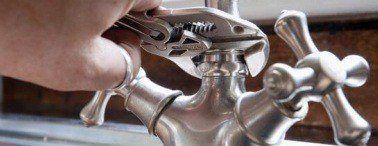
Home additions create more space, allowing you to feel comfortable in your home again. But several important plumbing issues may arise during this extensive renovation. In order to ensure your new addition provides the safe and cozy living space that you envision, it's best to take a close look at the plumbing system before construction begins.
Understanding the Plumbing In Your Home
Every home contains two subsystems of plumbing, including the supply lines that bring water into the building and the drain lines that carry wastewater out. If your home addition includes a kitchen, bath or laundry room both of these systems will need to be incorporated into the final design. Keep in mind that even living room or bedroom additions could involve changes to the existing plumbing.
The supply must be kept at the proper pressure. This depends on how the system was originally designed, as well as how the municipality or county handles the main supply. When adding bathroom or kitchen fixtures, like sinks, toilets and showers, the main plumbing design may need to be looked over and renovated in order to maintain the proper supply levels.
Mixing up different supply lines is also considered a bad idea for whole home plumbing design. If your existing supply lines are made from galvanized piping and your addition calls for copper lines, the connections are going to be a problem. Price out replacing the older galvanized lines with high quality and durable copper tubing. This may be more than you were planning on for the project, but it is wise to ensure that your supply plumbing lines are solid and dependable.
Make sure that the horizontal supply lines are sized at a 3/4†diameter. You can have 1/2" diameter lines installed near the plumbing fixture, but much of the system should include the larger diameter lines. Install pipe insulation (commonly called pipe wrap) on your hot water supply lines to achieve a higher level of efficiency as well.
How To Handle Drainage
Drainage is another issue when your home addition includes extensive plumbing. Older homes may be designed with a clay drainage line running out from the lower level of your home (generally the basement) to the street. This clay drainpipe can be found underground and may interfere with the placement of your home addition.
Current building codes will not allow you to construct a home addition on top of the existing clay drainpipe. Changing the addition location may be an option, but it's also possible to have the drainpipe removed and reinstalled in a new location. Modern technologies and designs may also be employed to create a better drainage system.
Have a plumber in to mark the depth and path of the clay piping. They may be able to do the renovation for you, but many general contractors will include this work in their initial quotation, as long as they are aware of the labor and materials involved.
Septic Issues
Septic systems are often used in rural and semi-rural locations as an efficient and affordable means of sewage treatment. Your existing septic tank and septic bed have been designed based on the number of plumbing fixtures in your home. Adding fixtures could potentially overload the current system.
If your septic tank is aging or worn, or the local building authorities perform an inspection and find the system lacking, you will be required to replace the septic before or during the home addition project. Permits are involved and the new septic system needs to be built according to current codes and designed to include the additional fixtures.
Hot Water Heaters
In the same way that your septic system is designed for your current fixtures, a hot water heater is sized to supply the existing home design. If you're adding a shower, tub or second kitchen in the new space the additional load may empty out the hot water heater too quickly.
Consider increasing the size of the hot water tank or replacing your old one with a tankless unit that provides heated water on demand. These newer designs are more expensive, but take up much less space in your home and operate at peak levels of efficiency. They also last for upwards of 15 years.
Most hot water heaters require a natural gas feed, which should be designed as part of your overall plumbing system. If the existing feed cannot support the addition of a larger or tankless model, that system may also need to be renovated.
Overall Plumbing Design
Just as is the case with any major renovation, it pays to take a close look at the overall design of your plumbing. Removing walls that contain major supply or drainage lines will require those lines to be relocated. Adding new fixtures or moving the existing fixtures could mean that further additions and renovations are needed. The supply and drainage lines need to be adequate to service your family's needs, and the septic system and hot water tank must be large enough to handle an additional load.
Your general contractor should have a plumber on staff to help out with your project. From finding the clay drainpipe to mapping out the new system and calculating the size of water heater required, an experienced plumber offers invaluable help during this project. Invest in a licensed professional and you won't be left with sloppy work, inefficient designs and inadequate fixtures.
Home additions require a massive amount of planning and work. Make sure that your plumbing does not get lost in the shuffle. The plumbing system needs to be looked at very closely when adding to your home or tackling extensive renos. Consider the supply and drainage pipes, the septic system and the hot water heater. All of these may need to be changed when a home addition occurs, although your plumber will give you an idea of the scope of those changes.
Posted by: TrustedPros





